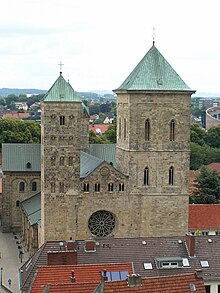St. Peter's Cathedral (Osnabrück)
| St. Peter's Cathedral | |
|---|---|
| Dom St. Peter | |

Osnabrück Cathedral. To the right is the southwest tower with the ringing bells.
|
|
| 52°17′N 8°3′E / 52.283°N 8.050°ECoordinates: 52°17′N 8°3′E / 52.283°N 8.050°E | |
| Location | Osnabrück, Lower Saxony |
| Country | Germany |
| Denomination | Roman Catholic |
| Website | www |
| History | |
| Founded | 785 |
| Architecture | |
| Status | Cathedral |
| Functional status | Active |
| Style | Romanesque, Gothic |
| Completed |
11th century (enlarged) 13th century (renovations) 1946 (reconstruction of tower) |
| Specifications | |
| Bells | 6 |
| Administration | |
| Diocese | Osnabrück |
| Clergy | |
| Bishop(s) | Franz-Josef Hermann Bode |
St. Peter's Cathedral in Osnabrück, Germany is the cathedral of the Roman Catholic Diocese of Osnabrück. The cathedral is a late Romanesque building and dominates the city's skyline.
The first version of St. Peter's Cathedral was built in the year 785, 15 years after the diocese was founded by Charlemagne. The Normans destroyed the church 100 years later, and the present version of the church developed only gradually after a fire around 1100.
The oldest parts of the present-day church are the Romanesque crossing tower, the northern facade and the Romanesque-Gothic west facade. The dome in the middle part of the three-aisled nave is as high as the pillars on which it rests.
The oldest pieces of equipment that have survived to this day are the baptismal font from 1220 and the triumphal cross from 1230. The broken rood screen from 1664 has also survived. Twelve statues received from the Münster sculptor Heinrich Brabender remain preserved to this day, including figures of the Christ and of the Apostles, and also a smaller number of statues received from Duke Erich II of Saxe-Lauenburg, Bishop of Münster. These are on display at the Diocesan Museum of Osnabrück.
Over the centuries, the cathedral changed in appearance - the interior primarily during the Baroque period, to which the altars, figures, and epitaphs bear testimony, and the exterior during the major restoration in 1882-1910 under Alexander Behnes through renovations and building of annexes. During the Second World War the cathedral roof with baroque domes and some church annexes were destroyed by incendiary bombs. The cathedral has since been rebuilt and is still a major attraction for the Christians of the city and the diocese as well as people interested in art history from around the world. The Osnabrück Wheel, which on September 13, 1944 fell from the larger of the towers due to bombing, has been re-erected at the side of the cathedral.
...
Wikipedia

